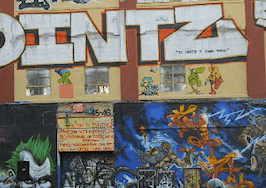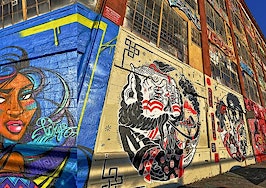Graffiti artists whose aerosol creations were destroyed five years ago when a developer in the New York City borough of Queens whitewashed the facade of his iconic Long Island City building were awarded an unprecedented $6.7 million in damages Monday by a New York judge, who issued a fiery rebuke against the builder.
Federal Judge Frederic Block announced the damages three months after a November ruling against Jerry Wolkoff, the owner of the former 5 Pointz factory building, whom the judge called “insolent” in a strongly worded courtroom admonishment Monday in a Brooklyn courtroom. Wolkoff had allowed his building to be covered by a large, colorful mural of street art that went on to gain international recognition as a symbol of New York.
“If not for Wolkoff’s insolence, these damages would not have been assessed,” Block said, according to court documents. “If he did not destroy 5 Pointz until he received his permits and demolished it 10 months later, the Court would not have found that he had acted willfully. Given the degree of difficulty in proving actual damages, a modest amount of statutory damages would probably have been more in order.”
In an unprecedented decision, jurors in November ruled largely in favor of 18 artists who accused Wolkoff of violating the national Visual Artists Rights Act when he painted over their graffiti on his Long Island City, Queens, building in 2013.
Jurors determined that some of the 49 pieces whitewashed at the iconic 5 Pointz building qualified under a “recognized stature” clause of the rarely tested Visual Artists Rights Act, which grants federal protection to distinguished works of art. The verdict could have wide-ranging implications for real estate developers nationwide, who may now be exposed to astronomical fines for the mishandling of art.
The trial, which began in October, centered around the destruction of mural-sized art covering the iconic 5 Pointz factory building at 45-46 Davis St. The artists accused Wolkoff of violating the federal Visual Artists Rights Act, which protects art of “recognized stature,” when he whitewashed the building in 2013 and demolished it a year later to make way for residential towers.
In his ruling, Block said Wolkoff’s decision to whitewash the building prior to demolition was willful, adding that the developer admitted during court proceedings that he was aware of the Visual Artists Rights Act, but chose to paint over the art to avoid a lengthy removal process. The artists receiving compensation are: Jonathan Cohen, Sandra Fabara, Stephen Ebert, Luis Lamboy, Esteban Del Valle, Rodrigo Henter De Rezende, Danielle Mastrion, William Tramontozzi, Jr., Thomas Lucero, Akiko Miyakami, Christian Cortes, Dustin Spagnola, Alice Mizrachi, Carlos Game, James Rocco, Steven Lew, Francisco Fernandez and Nicholai Khan.
“The sloppy, half-hearted nature of the whitewashing left the works easily visible under thin layers of cheap, white paint, reminding the plaintiffs on a daily basis what had happened,” wrote Block in his decision. “The mutilated works were visible by millions of people on the passing 7 train. One plaintiff, Miyakami, said that upon seeing her characters mutilated in that manner, it ‘felt like [she] was raped.’ It is simply untenable that a rational person could view the whitewashing as being in the best interest of the artists.”
A subsection of the Copyright Act, the 1990 Visual Artists Rights provision protects against “intentional distortion, mutilation or other modification,” but had rarely, if ever, been tested in court. Experts believe artists in the past may have either settled out of court or neglected to take legal action due to the costly price of litigation, especially for a young or emerging artist.
In one of the few cases in which the Visual Artists Rights Act has come before a court, the artist Ken Twitchell successfully sued the federal government after it whitewashed a Los Angeles building that served as the canvas of his 1987 mural “Ed Ruscha Monument.” Ultimately, however, the case was settled out of court for $1.1 million in 2006.
Another case involving the artist Katherine Craig and her “Illuminated Mural,” which had faced destruction at the hands of Princeton Enterprises, the developer that had owned the nine-story building on which the art is presented, earned a reprieve last year when new owners said the artwork could remain for “several years to come.” The case had been pending in U.S. District Court in Detroit.
“This is the largest amount of damages ever awarded to artists and I think it’s going to set a major precedent,” said Nicole Martinez, a managing editor at Orangenius, the publisher of Art Law Journal. “A lot of times developers lean on the arts community to help make a neighborhood become more vibrant and attractive, but once they get what they need out of them they forget the neighborhood was built on their backs. This is a really good opportunity to show the development community that if you’re going to work with artists you have to respect and honor that their work is protected under law.”
At 5 Pointz, Wolkoff was the rare developer in the real estate industry who willingly allowed street artists to cover the 200,000-square-foot building with colorful graffiti and vibrant murals. As early as 1993, the developer had welcomed the artists, but no contractual agreements are known to have been signed, and the artists themselves often painted over their own work.
Email Jotham Sederstrom





